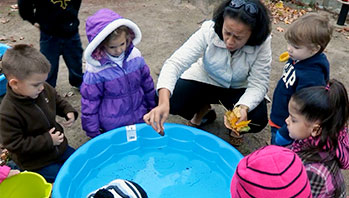- bricks
- camera (optional)
- chart paper
- clipboard
- containers of sand and other materials to fill gaps
- digging tools or sticks
- garden hose
- markers
- paper
- water containers (plastic buckets, bottles, and cups)
- dam
- flow
- water
- waterway
MA Standards:
Language/L.PK.MA.6: Use words and phrases acquired through conversations, listening to books read aloud, activities, and play.
MA Draft STE Standards:
Earth and Space Sciences/Earth’s Systems/ESS2.A: Observe, investigate, and classify the non-living materials, natural and human made, in their environment.
Earth and Space Sciences/Earth’s Systems/ESS2.C: Explore and describe the different places water is found in the local environment.
Head Start Outcomes:
Logic and Reasoning/Reasoning and Problem Solving: Classifies, compares, and contrasts objects, events, and experiences.
Science Knowledge/Conceptual Knowledge of Natural and Physical Worlds: Observes, describes, and discusses properties of materials and transformation of substances.
Science Knowledge/Scientific Skills and Method: Collects, describes, and records information through discussions, drawings, maps, and charts.
PreK Learning Guidelines:
English Language Arts/Language 2: Participate actively in discussions, listen to the ideas of others, and ask and answer relevant questions.
Science and Technology/Inquiry Skills 4: Record observations and share ideas through simple forms of representation such as drawings.
Science and Technology/Earth and Space Sciences 5: Compare and contrast natural materials such as water, rocks, soil, and living organisms using descriptive language.
Science and Technology/Physical Sciences 19: Explore, describe, and compare the properties of liquids and solids found in children's daily environment.
Explore Together (outdoors): Building Dams

© Commonwealth of Massachusetts, Department of Early Education and Care. All rights reserved.
STEM Key Concepts: Water flows downhill; You can change the direction water flows; Some surfaces absorb water, some don’t
ELA Focus Skills: Listening and Speaking, Vocabulary
Educator Prep: You may want to provide water smocks (garbage bags with holes for head and arms work well) to help keep children dry. Set guidelines about splashing and squirting.
Take children outdoors again to continue exploring the flow of water, this time to make dams. Make sure to review any rules and guidelines with children before letting them begin.
Have children use the hose or a container of water to create a flow of water. Show them the bricks, sand, and other materials. Let children freely explore making dams with the materials. Encourage children to work together. Bring the chart paper from the Talk Together activity outdoors to help children recall their ideas about which materials they might want to use and how.
After children have finished making their dams, help them use jugs of water or a garden hose to test the waterways they have built. Ask,
- Did the water stop flowing or is it passing through to the other side of your dam?
- Where is water passing through? What can you do to dam, or stop it from continuing to pass through? Introduce different ways of using the word dam as you talk with children as they explore.
Encourage children to note any changes in how the water flows as it passes through and around their dams. Does the water flow faster or slower? Where does it turn? Does it pool or collect? Use the words pool and dam frequently, and continue to prompt children to use those words to describe what they see and what they do throughout their explorations.
Take photographs and/or video children’s results. Have children draw the dams they made.
Reflect and Share
Once inside, talk with children about what they observed. Have them share their drawings as they talk. Use any photographs or video recordings you took and made of their explorations to help them recall. Ask, What materials worked best to make a dam? Were they the materials you thought would work best? How did you build your dam? Did you have any problems? How did you solve them?
